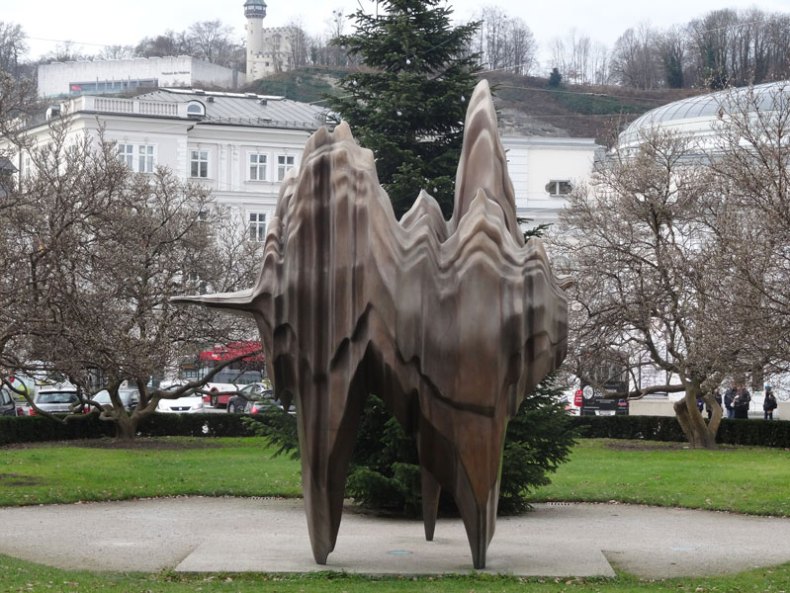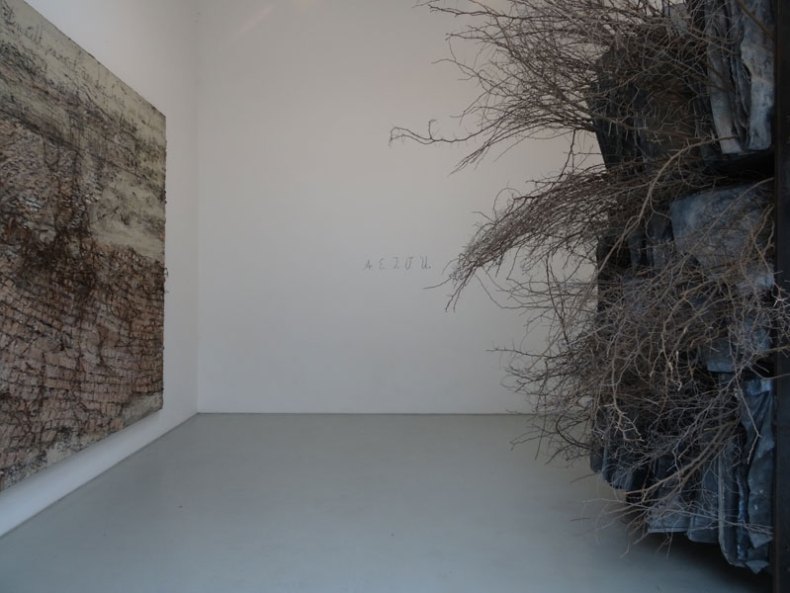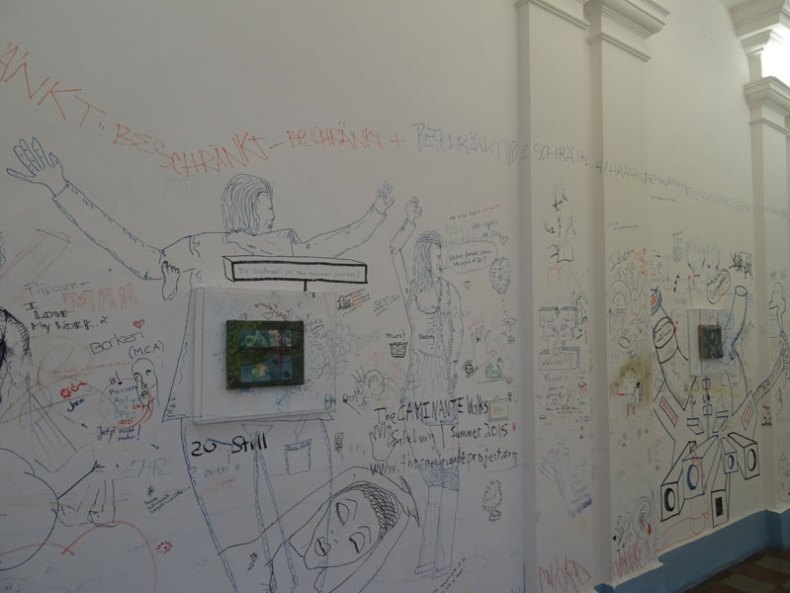Salzburg at Christmas is not the most obvious place to find cutting-edge art. Genteel crowds at the winter markets join the usual tourists seeking Sound of Music locations and Mozart memorabilia. It’s beautiful and fuelled by the crispest mountain air, but unmistakably twee, too. So serene is the atmosphere that it’s hard not to imagine what might lie beneath the perfect bourgeois veneer – a city waiting for a Michael Haneke film to happen.
There is, however, a surprisingly innovative flipside to all the cultural kitsch. Dominating the local art scene – both geographically and metaphorically – is the Museum der Moderne Salzburg, the main location of which looms over the city from a mountain top like a Bond villain’s hideout. Since director Sabine Breitwieser arrived from MoMA two years ago, the Moderne’s programming has undergone a significant shift with a particular emphasis now placed on post-1960s American art. Recent shows have included major retrospectives of Andrea Fraser and Carolee Schneemann as well as a survey of the group Experiments in Art and Technology (E.A.T.). Salzburg, unlikely as it seems, is becoming a crucial place to explore multimedia performance works, institutional critique and collaborative practice.

Caldera (2008), Tony Cragg. Photo: author’s own
Elsewhere in the city there’s evidence of a broader desire to move beyond the von Trapps and Mozartkugeln. A 10-year public art project completed in 2011 has left works by the likes of Tony Cragg and Marina Abramovic dotted around the picturesque bridges and squares, while the crypt of the city’s immense baroque Cathedral holds a wonderfully creepy sculpture by Christian Boltanski – a series of shadowy puppets led by a rotating Angel of Death, all sound-tracked by the banal terror of the speaking clock. Never one to let hidden histories lie still, Anselm Kiefer raised the spectre of Austria’s imperial past in his contribution to the project – an installation housed in a white bunker-like structure containing a massive painting, and a collection of lead sheets and thorn bushes.

A.E.I.O.U. (2002), Anselm Kiefer Photo: author’s own
Perhaps the most interesting developments in the city can be found away from these official projects. Galerie 5020 is a non-profit gallery supporting emerging Austrian artists that began operating in the early 1990s before moving in 2013 to its current location inside a building owned by the national postal service. The gallery’s curatorial strategy involves artists sharing the highly flexible exhibition space without clear demarcations between works by different individuals, alongside a commitment to shows evolving, sometimes dramatically, over their duration. Currently on display is a video work by Marlies Poeschl featuring lucid, static shots of a village near Shanghai, and an installation by Michael Poetschko that in its form and concerns – the possibilities of political change and the importance of collaboration and discussion – begins to blend with the broader environs of the gallery itself. Galerie 5020 also features an excellent library.
A more comic take on new forms of display is evident at the Salzburger Kunstverein, which houses 21 studios alongside exhibition spaces and a cozy café. Currently adorning the walls of the institution are a series of paintings by the director Séamus Kealy curated by the Bulgarian artist Nedko Solakov. Kealy’s work has been placed in Plexiglas boxes with visitors encouraged to ‘improve’ the paintings using marker pens. In the resultant scrawls and slogans that cover the works and adjacent walls there’s a further sense of a city desperate to sully its pristine postcard image.

Improvements (2015), Nedko Solakov. Photo: author’s own
Richard Martin teaches at King’s College London and Tate Modern, and is the author of The Architecture of David Lynch (Bloomsbury, 2014).

So long, farewell, auf Wiedersehn, good night to Salzburg’s kitsch cultural image
Salzburg seems eager to update its image with a variety of contemporary art venues and projects... Photo: author's own
Share
Salzburg at Christmas is not the most obvious place to find cutting-edge art. Genteel crowds at the winter markets join the usual tourists seeking Sound of Music locations and Mozart memorabilia. It’s beautiful and fuelled by the crispest mountain air, but unmistakably twee, too. So serene is the atmosphere that it’s hard not to imagine what might lie beneath the perfect bourgeois veneer – a city waiting for a Michael Haneke film to happen.
There is, however, a surprisingly innovative flipside to all the cultural kitsch. Dominating the local art scene – both geographically and metaphorically – is the Museum der Moderne Salzburg, the main location of which looms over the city from a mountain top like a Bond villain’s hideout. Since director Sabine Breitwieser arrived from MoMA two years ago, the Moderne’s programming has undergone a significant shift with a particular emphasis now placed on post-1960s American art. Recent shows have included major retrospectives of Andrea Fraser and Carolee Schneemann as well as a survey of the group Experiments in Art and Technology (E.A.T.). Salzburg, unlikely as it seems, is becoming a crucial place to explore multimedia performance works, institutional critique and collaborative practice.
Caldera (2008), Tony Cragg. Photo: author’s own
Elsewhere in the city there’s evidence of a broader desire to move beyond the von Trapps and Mozartkugeln. A 10-year public art project completed in 2011 has left works by the likes of Tony Cragg and Marina Abramovic dotted around the picturesque bridges and squares, while the crypt of the city’s immense baroque Cathedral holds a wonderfully creepy sculpture by Christian Boltanski – a series of shadowy puppets led by a rotating Angel of Death, all sound-tracked by the banal terror of the speaking clock. Never one to let hidden histories lie still, Anselm Kiefer raised the spectre of Austria’s imperial past in his contribution to the project – an installation housed in a white bunker-like structure containing a massive painting, and a collection of lead sheets and thorn bushes.
A.E.I.O.U. (2002), Anselm Kiefer Photo: author’s own
Perhaps the most interesting developments in the city can be found away from these official projects. Galerie 5020 is a non-profit gallery supporting emerging Austrian artists that began operating in the early 1990s before moving in 2013 to its current location inside a building owned by the national postal service. The gallery’s curatorial strategy involves artists sharing the highly flexible exhibition space without clear demarcations between works by different individuals, alongside a commitment to shows evolving, sometimes dramatically, over their duration. Currently on display is a video work by Marlies Poeschl featuring lucid, static shots of a village near Shanghai, and an installation by Michael Poetschko that in its form and concerns – the possibilities of political change and the importance of collaboration and discussion – begins to blend with the broader environs of the gallery itself. Galerie 5020 also features an excellent library.
A more comic take on new forms of display is evident at the Salzburger Kunstverein, which houses 21 studios alongside exhibition spaces and a cozy café. Currently adorning the walls of the institution are a series of paintings by the director Séamus Kealy curated by the Bulgarian artist Nedko Solakov. Kealy’s work has been placed in Plexiglas boxes with visitors encouraged to ‘improve’ the paintings using marker pens. In the resultant scrawls and slogans that cover the works and adjacent walls there’s a further sense of a city desperate to sully its pristine postcard image.
Improvements (2015), Nedko Solakov. Photo: author’s own
Richard Martin teaches at King’s College London and Tate Modern, and is the author of The Architecture of David Lynch (Bloomsbury, 2014).
Unlimited access from just $16 every 3 months
Subscribe to get unlimited and exclusive access to the top art stories, interviews and exhibition reviews.
Share
Recommended for you
12 Days: Highlights of 2016
Maria Balshaw picks robots at the Manchester Art Gallery, Mona Hatoum at Tate Modern, hard-hitting photographs at Birmingham’s Ikon gallery and underwear at the V&A
12 Days: Highlights of 2016
Fatema Ahmed looks forward to John Akomfrah’s films at Lisson Gallery, a second edition of Photo London, and a mysterious show curated by Michel Houellebecq
Protesting against a historical statue is not just childish – it’s bigoted, too
‘Attitudes change, fortunately, but…things we now find offensive cannot be airbrushed away.’